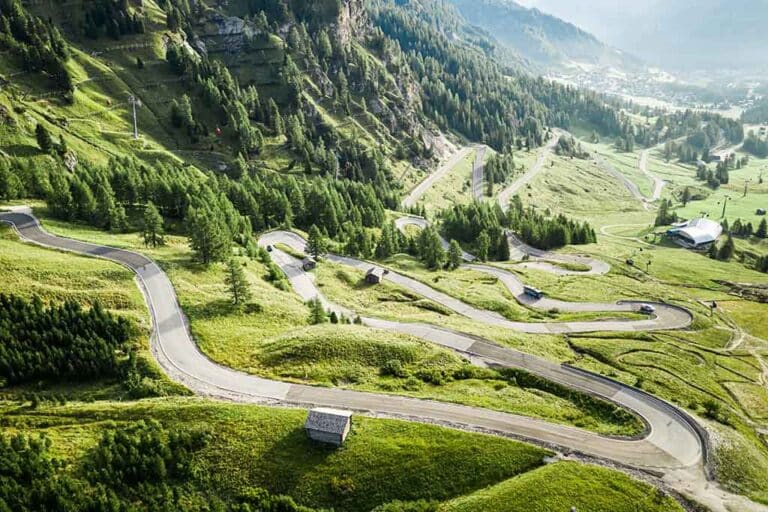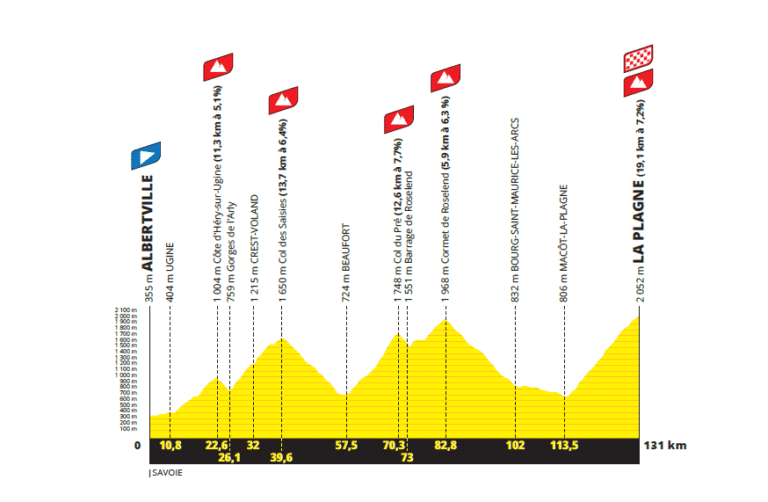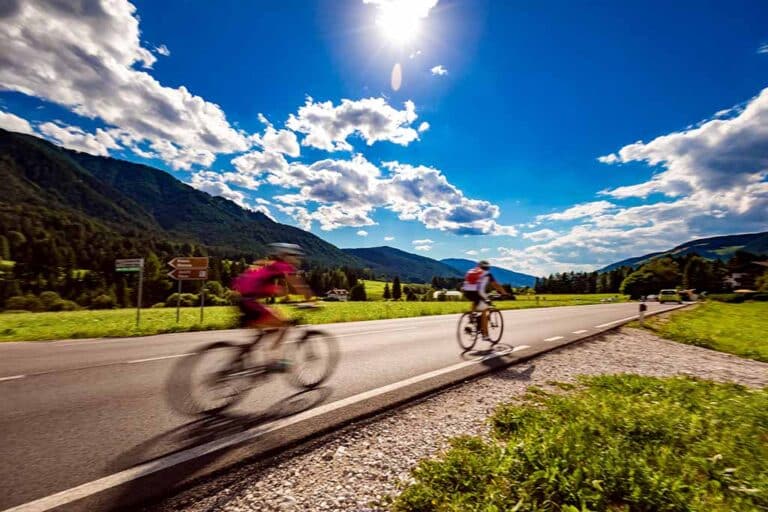Thinking of tackling the Étape du Tour in 2025? There are still opportunities to join this iconic race. Now in its 33rd edition, the Étape gives amateur cyclists the rare chance to ride a full mountain stage of the Tour de France—on closed roads, with full support, and all the atmosphere of the real thing. Each year, over 15,000 riders from around the world take on the challenge.
For UK road cyclists, it’s the ultimate bucket-list event, a test of fitness, mental grit and sheer determination, all wrapped up in a spectacular day out in the French Alps or Pyrenees. This guide covers everything you need to know to get to the start line confident and ready to ride.
A brief history of L’Étape

The Étape du Tour, or “The Stage of the Tour,” began in 1993, created by the organisers of the Tour de France (ASO). The idea? To give amateur cyclists a taste of what the pros experience during a full mountain stage.
Each year, one of the toughest mountain stages from the actual Tour de France is selected and recreated for amateurs to ride—complete with closed roads, feed stations, mechanical support, and a roaring crowd atmosphere. Past routes have included legendary climbs like Alpe d’Huez, Col du Tourmalet, and Mont Ventoux. The sense of authenticity is what makes the Étape so beloved.
Key race information for L’Étape du Tour 2025
- Date: Sunday 20th July
- Start & Finish: Albertville to La Plagne
- Distance: 131km (or 80 miles).
- Elevation: 4500 metres of ascent.
Route information

The 2025 route will follow the 19th stage of the Tour de France that the pros will tackle a few days later. Ascending 5 cols and finishing in the ski resort of La Plagne, here are some key features:
HC (Hors Catégorie) climbs
Côte d’Héry-sur-Ugine
- Distance: 11.3 km
- Average Gradient: 5.1%
Col des Saisies
- Distance: 13.7 km
- Average Gradient: 6.4%
Col du Pré
- Distance: 12.6 km
- Average Gradient: 7.7%
Cormet de Roselend
- Distance: 5.9 km
- Average Gradient: 6.3%
La Plagne (Final Climb)
- Distance: 19.1 km
- Average Gradient: 7.2%
Technical descents
- Col des Saisies to Beaufort
- Col du Pré to Cormet de Roselend base
- Cormet de Roselend to Aime-la-Plagne
Altitude
At 344 metres at the race start riders will climb to 1004 metres at the first col and finish the race at 2052 metres in La Plagne.
There are multiple resources to analyse the route and hear technical commentary on what to expect.
How to take part
There are several ways for UK cyclists to enter:
- Direct Entry: Through the official ASO website. Entries sell out fast, and for 2025 are now complete. If you missed this year, entries open in November for 2026.
- Tour Operators: Companies like Sportive Breaks, Brevet and La Fuga offer packages that include guaranteed entry, accommodation, transfers and support.
- Charity Places: Ride for a UK charity that has allocated spots. It’s a great way to fundraise while tackling a major personal challenge.
Prices vary but expect to pay around £60-£90 for entry alone, with full packages ranging from £600 to over £1000 depending on the level of support.
Safety considerations

The Étape du Tour is not your average Sunday club ride—it’s a serious physical and logistical challenge that takes place at altitude, in mountainous terrain, often under intense heat. While the event organisers do an excellent job with support, it’s essential to be personally prepared for both your safety and wellbeing throughout the day.
Medical and event support
- The event is professionally run and includes on-route medical teams, ambulances, and mobile paramedics on motorbikes who can quickly respond to incidents along the course.
- Support vehicles, including broom wagons and mechanical support vans, sweep the course and assist riders in distress or those unable to continue within the time limits.
- In the event of an accident or crash, medics will assess and treat on-site, and if needed, evacuate you to a local hospital. Make sure you carry ID and any necessary medical information in your jersey pocket or helmet tag.
- Each rider is tracked electronically, so the organisers will know your location on the course and whether you’ve finished safely.
Nutrition & energy management
- Feed zones are spaced out along the route, typically every 30–40km, and are stocked with essentials: water, energy drinks, fruit, bars, cake, and even salted snacks to combat cramps.
- That said, don’t rely solely on feed zones. Bring your own familiar energy gels, bars, and hydration tabs to avoid stomach issues and ensure you’re fuelling consistently.
- A good rule of thumb: eat something every 30–45 minutes, and sip fluids regularly, especially during climbs and in the heat.
Fitness requirements
- To take part in the Étape, you’ll need to supply a valid medical certificate, signed by your GP or a private practitioner, stating that you are fit to compete in amateur cycling events. This is a legal requirement under French law.
- Think of it this way: if you can comfortably complete something like the Fred Whitton, Dragon Ride or a 100-mile hilly sportive in the UK, you’re likely on the right track.
Cycling Sportive Insurance
- Standard travel insurance often doesn’t cover amateur cycling events or sportives – check you have suitable cover to protect you and your equipment.
- You’ll need a cycling policy that specifically covers participation in timed, organised events, including medical repatriation, accident cover, and theft or damage to your bike.
Training plans to consider
Be honest – this isn’t something you can wing. With multiple long climbs, fast descents and the possibility of sweltering heat, you’ll need to arrive fit, confident, and fully prepared. With the right training, it’s absolutely doable.
Ideally, you should start building your base fitness at least 6 months out, then gradually ramp up the volume and intensity. Think of your training in three phases: base, build, and peak. Here’s what to focus on:
- Endurance rides (3–6 hours): Long weekend rides help build stamina and get your body used to spending hours in the saddle.
- Hill repeats and sustained climbing: Seek out long climbs or simulate them on local gradients. Repeats on known hills are great for building leg strength and mental grit.
- Group rides: These are brilliant for getting used to riding in a bunch, managing pacing, and practising positioning—especially useful on busy parts of the Étape route. Local club rides are perfect for this.
- Sportive targets: Entering UK sportives like the Fred Whitton Challenge, Dragon Ride, or RideLondon 100 gives you big-day experience. They also help test your fuelling strategy, kit choices, and climbing ability under pressure.
- Training camps: If you really want to prepare properly (and have the time and budget), consider an early-season trip to the Alps, Pyrenees or Mallorca. These camps give you a taste of long alpine climbs and back-to-back riding days, which are invaluable prep.
To help riders prepare, the event organisers usually release a free 12-week training plan in the run-up to the event. It’s designed by professional coaches and tailored specifically for the demands of the Étape.
Taking your bike abroad vs hiring

This is one of the biggest logistical decisions you’ll face. Both options have their pros and cons, and what’s right for you will depend on your budget, travel plans, and how comfortable you are with bike setup and maintenance.
Taking your own bike
For many riders, nothing beats the familiarity of their own bike. You know how it fits, how it handles, and it’s already dialled in for climbing, descending, and long hours in the saddle.
Here’s what to consider:
- Use a quality bike box or case: A hard case like a BikeBox Alan, Scicon or Thule will protect your bike from knocks and scrapes in transit. Make sure your bike is properly padded and secure.
- Choose a bike-friendly airline: British Airways, Jet2 and EasyJet can accommodate bikes as sports equipment or oversized luggage, though fees and conditions vary. Always check in advance and book bike carriage early.
- Arrive early: Give yourself time to reassemble your bike on arrival and take it for a short spin to check everything’s working, especially gearing, brakes and tyre pressure.
- Bring tools and spares: Don’t rely on local shops having everything you need. Pack a mini tool kit, torque wrench, spare tubes, CO2 or a pump, and brake pads.
Hiring a bike
Hiring a bike can be a convenient and stress-free option, especially if you’re combining the Étape with a holiday or don’t want the hassle of transporting a large bike case.
Here’s what to keep in mind:
- Availability: Many local and international operators rent high-end road bikes, especially in host towns close to the Étape start. Popular brands like Cannondale, Trek, Bianchi and Specialized are common.
- Book early: Demand spikes around the Étape, so reserve your bike months in advance to ensure availability and get your preferred size and model.
- Bring your essentials: To make the hire bike feel more like your own, bring your own pedals, shoes, saddle, and possibly even your GPS computer mount. Many shops will help fit these for you when you collect the bike.
- Check the spec: Confirm gearing in advance (compact or sub-compact is ideal for mountain stages), and ensure the bike is in good condition when you collect it.
Travel planning
Flights: Try to fly into the closest regional airport to the start or finish—Geneva, Lyon or Toulouse are usually good bets depending on the final route.
Trains: If you prefer a more relaxed journey, you can take the Eurostar to Paris, then hop on a TGV (high-speed train) to get closer to the mountains. It’s scenic, and often less hassle than flying with a bike.
Accommodation: Book early—places near the start and finish towns fill up quickly, especially if you want somewhere with bike storage or easy access to the race village.
Transfers: If you’re using a tour operator, transfers are usually sorted for you. If not, you’ll need to arrange a local taxi or shuttle that can take bikes—some minibuses in mountain towns are set up for this, but book ahead to be safe.
Other useful considerations
Nutrition: Don’t wait until race day to test your gels or drinks. Practice your fuelling strategy on long rides so your stomach knows what’s coming and you’re not running on empty halfway up a mountain.
Gear: The weather in the Alps or Pyrenees can change in minutes. Make sure you’ve packed for all conditions, arm warmers, a lightweight gilet, and a decent rain jacket are non-negotiables.
Bike Prep: Make sure your bike is geared for climbing. A compact chain set and fresh brake pads are absolute musts, you’ll be glad for the easier gears and reliable stopping power on those long descents.
Mental Prep: There will be moments when it gets tough, everyone has them. Try visualising the finish line, break the ride into chunks (like “just get to the next feed stop”), and remember why you signed up in the first place.
What makes the Étape so popular?
The Étape du Tour isn’t just another sportive—it’s a true pro-level experience that draws thousands back year after year. With its iconic climbs, closed roads, and Tour de France atmosphere, it offers an unforgettable mix of challenge, scenery, and camaraderie. Whether you’re riding solo, with mates, or for a cause, it’s a journey that tests your limits and rewards you with memories that last a lifetime. For many UK cyclists, it’s the ultimate badge of honour. Ready to take it on?
Get Cycling Insurance form SportCover Direct
SportsCover Direct’s cycling insurance has been designed to give protection for worldwide cycling travel, whatever cycling challenge you’re pursuing make sure you have the right insurance to cover you for injuries and other travelling incidents.
Our cycling travel insurance covers you abroad, whether you’re enjoying the sport for leisure or cycling competitively. It offers cover for medical costs, equipment, cancelled trips and more. If you already have travel insurance, our bolt-on allows you to add the protection you need for cycling. You can also opt for our sports accident insurance, which has been created to protect you while cycling in the UK.
Find out more and get an instant quote designed to suit you.
This blog has been created as general information and should not be taken as advice. Make sure you have the correct level of insurance for your requirements and always review policy documentation.